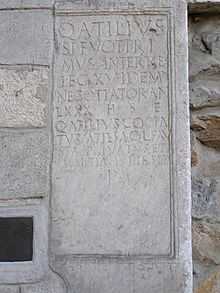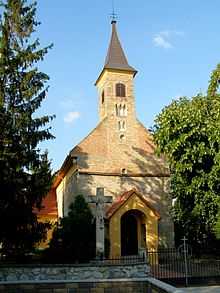Boldog, Slovakia
| Boldog | |
| Boldogfa | |
| Village | |
| Country | Slovakia |
|---|---|
| Region | Bratislava |
| District | Senec |
| Elevation | 123 m (404 ft) |
| Coordinates | 48°14′20″N 17°25′46″E / 48.23889°N 17.42944°E |
| Area | 4.5 km2 (2 sq mi) |
| Population | 426 (2011) |
| Density | 95 / km2 (246 / sq mi) |
| First mentioned | 1245 |
| Mayor | Alajos Časný |
| Timezone | CET (UTC+1) |
| - summer (DST) | CEST (UTC+2) |
| Postal code | 925 26 |
| Phone prefix | 421-2 |
| Car plate | SC |
  Location in Slovakia
| |
  Location in the Bratislava Region
| |
| Statistics: MOŠ/MIS | |
| Website: http://www.boldog.sk | |
Boldog or Pozsonyboldogfa (in Slovak: Boldog, in Hungarian: Pozsonyboldogfa) is a village and municipality in western Slovakia in Senec District in the Bratislava Region.
Geography
The municipality lies at an altitude of 124 metres and covers an area of 4.496 km2. It has a population of about 433. [1]
History
In the 9th century, the territory of Boldog was part of Greater Moravia, and from 1026 part of the Kingdom of Hungary. In historical records the village was first mentioned in 1245. After the Austro-Hungarian army disintegrated in November 1918, Czechoslovak troops occupied the area, later acknowledged internationally by the Treaty of Trianon. Between 1938 and 1945 Boldog once more became part of Miklós Horthy's Hungary through the First Vienna Award. From 1945 until the Velvet Divorce, it was part of Czechoslovakia. Since then it has been part of Slovakia.
Roman Inscription
In 1978, during restoration work in the church, a remarkable gravestone for a Roman Centurion of Legio XV Apollinaris, who is also described as a 'Negotiator' or trader, was found in the wall of the sacristy. The inscription is as follows:
Q ATILIVS SP.F.VOT.PRI MVS.INTER R EX LEG XV.IDEM. NEGOTIATOR.AN LXXX. HSE Q.ATILIVS COCI TUS.ATILIA QL EAV STA.PRIVATUS.ET MARTIALIS.HERED P L

According to Dr. Titus Kolník[2] inscription translates as: Quintus Atilius Primus, son of Spurio Tribune Votbrimus (or of the tribe Voturina.[3] Interpreter XV. Legion centurion and businessman. He lived 80 years, is buried here. Quintus Atilius Cogitatus, Atilia, Quint L EAV Privatus and Martialis heirs. P had erected. The XV legion was stationed at Carnuntum, a Roman Limes, or frontier fort on the Danube and the gravestone is likely to date from between 90-138AD. As Boldog lies between Bratislava and Trnava, to the east of the Danube, Quintus Atilius Primus must have died outside the area of the Roman Empire. This might indicate that there was a trading post in the vicinity, to which he moved after his career in the Roman Army.
The Parish Church
The Church, dedicated to the Assumption of the Blessed Virgin Mary is one of a group of Romanesque churches in Western Slovakia. The first phase dates from first half of the 12th century, or even the 11th century AD. Around 1220 the church was extended to the west, and a tower built with a triple tiered arrangement of Romanesque window openings.
Other Romaneque features include a finely carved baptismal font, a decorative Tympanum over the west door and grotesque animal head brackets below the eaves of the roof.[4] In 1280 the Church and the village came into the ownership of the Poor Clares and between 1364 and 1370 they made modifications to the church in the Gothic style.[5]
Demography
Population by nationality:
| Nationality | 1991 | 2001 | 2011 |
|---|---|---|---|
| Hungarians | 79.80% | 70.30% | 56,07% |
| Slovaks | 18.20% | 24.50% | 37,38% |
| Czechs | 1% | 1.8% | 0,2% |
| English | 0,70% |
References
- ↑ http://portal.statistics.sk/files/Sekcie/sek_600/Demografia/Obyvatelstvo/tabulky/pocet_obyvatelov/2012/poc_obyv_2012.pdf
- ↑ T Kolnik, ‘Q. Atilius Primus-Interprex, Centurio und Negotiator’, Acta Arch Hungarica 30 (1978), 61
- ↑ H Elton 'Frontiers of the Roman Empire', Routledge 2013, 80, gives an alternative translation 'Here lies Quintus Atilius Primus, son of Spurius, of the tribe of Voturina, interpreter of legio XV, centurion of the same, 80years old. His heirs Quintus Atilis Cositutus, Atilia Quinta freedwoman, Fausta and Martialis placed this
- ↑ Oriško, Š.: Románske umenie na Slovensku - maliarstvo a sochárstvo. Filozofická fakulta Trnavská univerzita v Trnave, Trnava 2009.
- ↑ www.apsida.sk - profil románskeho kostola- a website discussing Romanesque churches in the Bratislava area
External links/Sources
| Wikimedia Commons has media related to Boldog, Slovakia. |